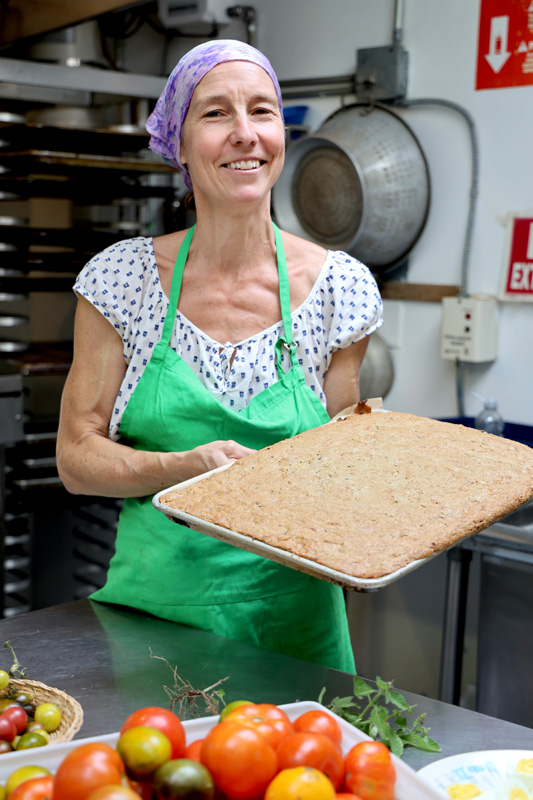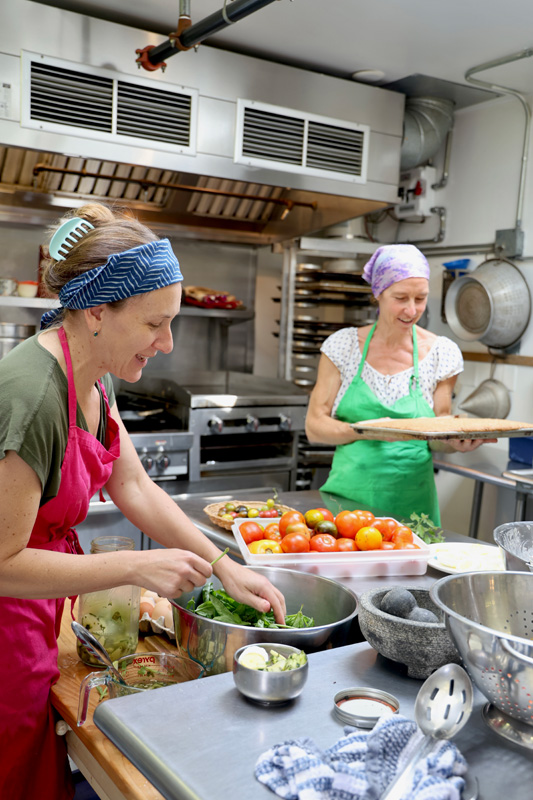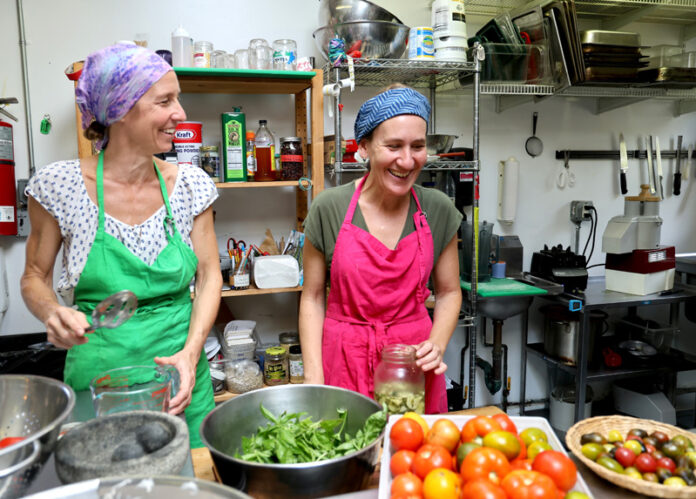Five years ago, Martha’s Vineyard Public Charter School head chef Betsy Carnie imagined a new school kitchen for students. “I wanted to start from scratch. I had a few lines in the sand. For instance, we would only serve meat from here and offer local Massachusetts milk. No seed oil, because no industrial fats for growing bodies. Butter or olive oil instead. I wanted to reduce waste — from using seconds from the grocery store to less food waste to using as little plastic and single use containers as possible. But I also wanted to communicate to the students and staff the idea that we are part of a food continuum. There’s the soil, the seeds, the farmers planting the seeds, the people who harvest our food, the movement of food from one place to us, the preparation and eating it — these are all important relationships. And there are stories about the food at each step along the continuum.”
When Betsy started, the Charter School administration appreciated her big vision, but they feared she would not be able to afford to make the food she dreamed of. Betsy has forged relationships with farms and markets around the Island to realize this dream and keep the kitchen financial books in balance. Native Earth Teaching Farm, Up-Island Cronig’s, Slough Farm, Mermaid Farm, Beetlebung Farm, Grey Barn, Morning Glory Farm, Island Grown Initiative (IGI), Blackwater Farm, Dan Sternbach, Wendy Goldfarb, Cash and Carry, and many Charter School parents with gardens, among others, are her collaborators. “The eggs from Slough Farm are amazing. I ask the kids, ‘Can you taste the salty fresh air in these chickens’ eggs?’ The color of the yolks — just extraordinary. And Dan Sternbach’s flour? Incredible! Up-Island Cronig’s is amazing. They will call and say, ‘Can you use a case of endive that is on its way?’ I say, ‘yes’ and then figure out what to do with it.” (She grilled the endive and served it.)

Did all the kids eat the grilled endive? No, but, Betsy explains, “I want the food to be an invitation not a requirement. It’s about presenting choices. For instance, I will make a basic pizza, but then I will offer what I call crazy options to put on top like a homemade pesto made with portulaca. The teachers and older students love the crazy. The younger kids see the older kids eating the crazy stuff and maybe say to themselves, ‘When I get older, I want to eat like that too.’ So then, eventually, they might make the choice to try it, which means they get into the practice of trying things. And that is important. Because they are practicing engaging with food and the food continuum that I am talking about.”
While Betsy loves to offer choices for students, another unique aspect of her meal plan are cards that describe each dish. The story of bay leaves in two parts. First, the idea that Laurus nobilis is where we get the term “baccalaureate,” which the Charter School program offers. And then another meal includes bay leaves and she shares the Greek myth of Apollo, where Apollo is the visual depiction of a bay leaf! It sounds heady, but her hand-drawn and written notes to students appeal to all ages and include funny things like a wacky crown for dates, the queen of fruit for Ramadan.
“I try to always include an adjective or something to describe the food in the cards. Homemade is a big one. Local another. And Island a big one. These are our Island’s apples. This is our yogurt. Kids will eat the food and feel ownership. Someone they might know grew this food in a field they passed on the way to school. Through eating local food, they are connected and related to the food in so many ways.”


Betsy admits that her vision for school food has also changed and been influenced by the folks eating her food. “For the first three years, I refused to serve hot dogs. But the kids kept requesting them. After COVID, I started serving them. I source them from Kayem, a farm in Chelsea, Mass. We also source our bacon from them. I like being able to say, ‘Someone requested this.’ As a result, they feel heard and cared for. Kids will ask, ‘When is it time for strawberry shortcake?’ Or ‘When is it time for hot chocolate? So it feels like the kitchen is always in conversation with the kids. But we also respond to the staff.’ Teachers also request food as part of their curriculum.”
Kindergarten teacher Lori DiGiacomo, who has taught at the Charter School for 21 years, tells us, “Betsy is a teacher. Today she shared at morning circle that the kitchen needed more ice cube trays. She found some at the Dumptique and explained that when we need things we don’t always have to look for or buy something new. So much is woven into her food with presentation and predictability. Kids are exposed to a different way of being in relationship to food. So different from food in packets or slopped onto a plastic tray. For some of my kids, it’s their first experience with a real piece of fruit. A real piece of cantaloupe. We don’t use straws, we have water bottles and mason jars for milk. Real silverware. Beautiful plates. The kids are learning at an early age about how to compost. Her food makes me feel really happy. Our lunchtime at school is a happy experience. And she does all this without dogma. She is just bringing thirsty people water, doing her part. She has changed my little kids’ lives.”

Technology facilitator at the Charter School Maribeth Macaisa agrees, saying, “I think the easiest way to put it, and I’ve even heard a student say this, is that there is real food here. We know what the food is, where it was grown, its nutritional value, even its history. This is a level of education that is really special. It’s refreshing. I love it.”
Betsy’s father was a school teacher. “He hunted and fished. We ate squirrels and eels. He had — and still has — a beautiful garden. So I grew up with the understanding that we could live off the land near us. I am so grateful for being raised this way. It was the best education of my life.” That’s a big statement from someone who was also educated by Wellesley College and has a graduate degree in curriculum design from Columbia University.
“I put my heart and soul into the food, but I also like the food to have a handmade quality. To show that it is OK to not be perfect. This is a home kitchen at school. I want the feeling to be: this food was made for you,” Betsy said.
“Generally speaking, on Tuesdays, we have homemade pinto beans with rice, homemade pico de gallo, a zippy cilantro sauce, Cabot shredded cheese, Cabot sour cream, and other odds and ends. Wednesdays are pizza day, with homemade pesto and big crunchy salad. This Thursday, we got turkey meatballs with homemade cranberry sauce, potatoes, and baked apples. Friday is ‘breakfast for lunch,’ which always includes pancakes with Dan Sterbach’s local rye flour and wild blueberries from Wymans. This also serves as a catchall for other odds and ends we’ve gotten in during the week. For instance, last Friday also included a quiche and a big, crunchy salad, silver queen corn from Morning Glory. And right now, I think we have had either local watermelon or local apples as our fruits alongside the lunches every day,” Betsy says.

Of course she doesn’t do all this alone. “I also want to mention Jenik Munafo and Carrie Welch who work with me.” Betsy says, “They both bring so much to the kitchen. And Jenik has a wealth of culinary language — from her travels to running Little House.”
Betsy’s newest kitchen addition includes using recycled glass jars. “I ditched the jelly jars and started using things like salsa and pickle jars to work with and serve food in. These are truly reclaimed, going from one use to another, and can be reused endlessly.” She also continues to refine her sourcing. She only offers things like oranges from out of state in the winter months, and uses Bragg apple cider vinegar instead of lemons. “Unless Cronig’s gives me a bunch,” she laughs. “I love when they call me and say, ‘I’ve got some good stuff for the kids.’ It just feels great. Or when IGI’s Astrid Tilton will call and say, ‘I’ve got wild spinach.’ The Chenopodium album is actually higher in iron. And I can tell the kids this and say, ‘Astrid picked this for us. It is called goosefoot.’ And it is all so intriguing and exciting that they make the choice to take a bite.”


